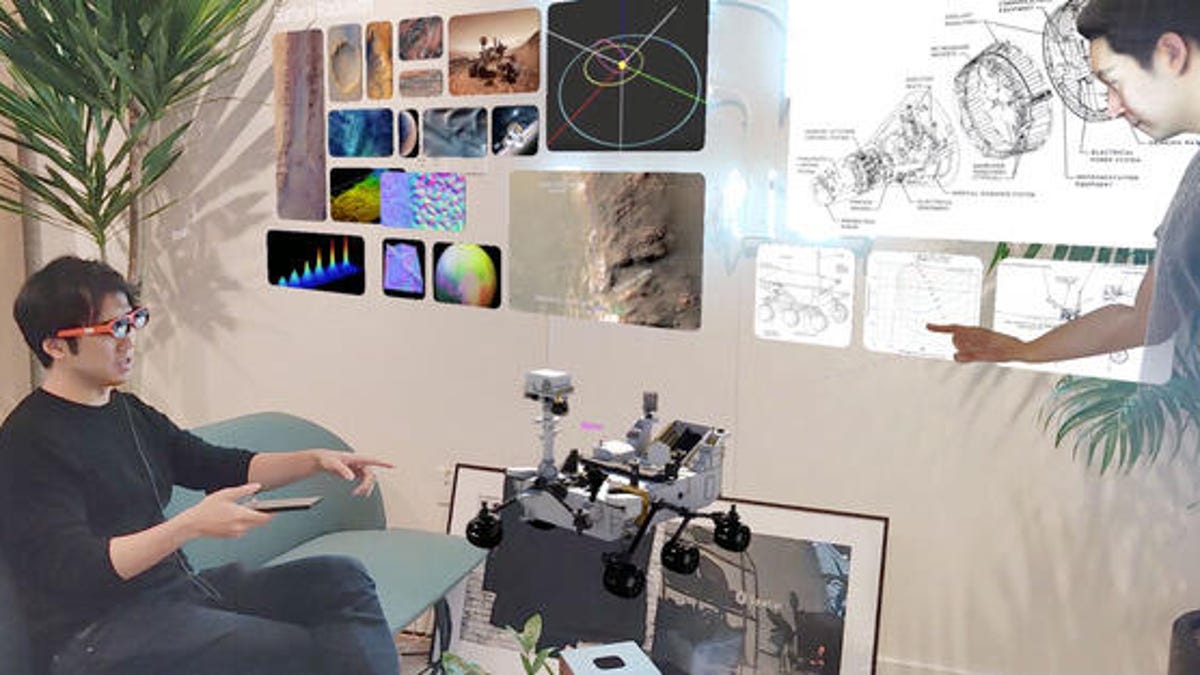I got a peek at what your 5G-enabled AR home office could look like
Minus the 5G part, that is. Spatial's collaborative avatar app shows the promises, and challenges, of the virtual remote-work future.

Sitting down, bringing up holographic coworkers, wearing phone-connected Nreal AR glasses. Spatial's working on 5G connectivity soon.
Standing in a holographic office space half-layered into the real room I was in, back in February, I lifted my hand to a wall full of faces of myself, pulled from Google . I dragged one across the room to where a group of people stood -- some real and standing with me, others were avatars. Dragging my finger across a phone screen like a touchpad, I controlled the virtual things hanging in space that I saw through the augmented reality glasses I had on.
It's a rough experience, but one that shows some weird potential. If we're facing a future where we work from home more and telecommute, will AR like this be a part of it? Did I see a preview of our VR/AR coworking future, or a demonstration of the roadblocks?
The compact AR glasses, made by Nreal, have surprisingly good resolution but didn't fit my prescription (I had to hold them up to my face). And using the connected LG phone as a touchpad was a bit rough at times, sometimes not tracking movement that well. But it worked, letting me collaborate with other people in the room wearing a HoloLens 2 and working on laptops and phones . Eventually, this is supposed to run on a 5G network. I haven't gotten to try that part out yet.
Holographic high-five.
AR, for all its promises, doesn't have many killer apps yet. Meanwhile, 5G networks are barely on their feet, and not yet ready to help AR hardware do processing in the cloud that will make smart glasses, in theory, work anywhere. And if we're all going to be wearing AR smart glasses in our interconnected 5G future, we'll need to have a good reason. Is this is the answer to WFH challenges we're all facing now? Is office work going to work via digital telepresence? What I saw a month ago felt like the first baby steps.
Spatial, a collaborative telepresence software company whose apps I've tried before, are partnering with AR glasses maker Nreal, Qualcomm (which makes the chips in most mobile AR/VR glasses, as well as most phones) and a variety of international 5G carriers (LG Uplus, KDDI and Deutsche Telekom), to try to make its flexible multiplatform collaborative app work in offices, or anywhere. The lower-cost Nreal glasses I tried are an early indicator of a wave of USB-C-connected, phone-tethered glasses that Qualcomm is powering with its latest chips.
Googling myself.
The semi-virtual office I experienced at Spatial's downtown New York offices with Nreal's glasses was just an early prototype, and there's still a lot that needs ironing out. But I got to see something that worked on a $500 headset and phone that seemed to work, in some ways, as well as a pricier HoloLens . My demo was done over Wi-Fi, not 5G, but 5G should make the early experience I tried work even more smoothly.
Besides 5G networks providing low latency and cloud rendering to prevent the prototype phone I held from overheating (which it did), the other thing phone-connected AR headsets need is software that works easily. Google and Apple don't make it easy for plug-and-play AR headsets to use apps on phones, but maybe iOS and Android will eventually work support for headsets into their OSes to make that inevitable fusion smoother.
I had to hold the glasses up a bit (prescription lenses forthcoming).
Spatial is trying to pave a road for multiplatform AR/VR that's not really here yet, and it's fascinating to try it out. We all stood over a 3D map of Mars while we dragged a rover onto it. We scribbled notes to each other. Our positions in space could be viewed remotely, or saved like a 3D recording of our avatars, interacting. It's also a work in progress. It feels like a collaborative future with training wheels on. I'm curious to see it become a lot more unleashed... but I'm not sure what the timeframe on that will be.

